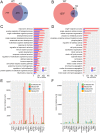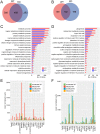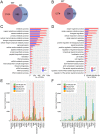Transcriptional profiling of Toll-like receptor 2-deficient primary murine brain cells during Toxoplasma gondii infection
- PMID: 29136637
- PMCID: PMC5685635
- DOI: 10.1371/journal.pone.0187703
Transcriptional profiling of Toll-like receptor 2-deficient primary murine brain cells during Toxoplasma gondii infection
Erratum in
-
Correction: Transcriptional profiling of Toll-like receptor 2-deficient primary murine brain cells during Toxoplasma gondii infection.PLoS One. 2024 May 2;19(5):e0303453. doi: 10.1371/journal.pone.0303453. eCollection 2024. PLoS One. 2024. PMID: 38696514 Free PMC article.
Abstract
Background: Toxoplasma gondii is capable of persisting in the brain, although it is efficiently eliminated by cellular immune responses in most other sites. While Toll-like receptor 2 (TLR2) reportedly plays important roles in protective immunity against the parasite, the relationship between neurological disorders induced by T. gondii infection and TLR2 function in the brain remains controversial with many unknowns. In this study, primary cultured astrocytes, microglia, neurons, and peritoneal macrophages obtained from wild-type and TLR2-deficient mice were exposed to T. gondii tachyzoites. To characterize TLR2-dependent functional pathways activated in response to T. gondii infection, gene expression of different cell types was profiled by RNA sequencing.
Results: During T. gondii infection, a total of 611, 777, 385, and 1105 genes were upregulated in astrocytes, microglia, neurons, and macrophages, respectively, while 163, 1207, 158, and 1274 genes were downregulated, respectively, in a TLR2-dependent manner. Overrepresented Gene Ontology (GO) terms for TLR2-dependently upregulated genes were associated with immune and stress responses in astrocytes, immune responses and developmental processes in microglia, metabolic processes and immune responses in neurons, and metabolic processes and gene expression in macrophages. Overrepresented GO terms for downregulated genes included ion transport and behavior in astrocytes, cell cycle and cell division in microglia, metabolic processes in neurons, and response to stimulus, signaling and cell motility in macrophages.
Conclusions: To our knowledge, this is the first transcriptomic study of TLR2 function across different cell types during T. gondii infection. Results of RNA-sequencing demonstrated roles for TLR2 varied by cell type during T. gondii infection. Our findings facilitate understanding of the detailed relationship between TLR2 and T. gondii infection, and elucidate mechanisms underlying neurological changes during infection.
Conflict of interest statement
Figures










Similar articles
-
Transcriptome analysis of the effect of C-C chemokine receptor 5 deficiency on cell response to Toxoplasma gondii in brain cells.BMC Genomics. 2019 Sep 11;20(1):705. doi: 10.1186/s12864-019-6076-4. BMC Genomics. 2019. PMID: 31506064 Free PMC article.
-
TLR2 as an essential molecule for protective immunity against Toxoplasma gondii infection.Int Immunol. 2003 Sep;15(9):1081-7. doi: 10.1093/intimm/dxg108. Int Immunol. 2003. PMID: 12917260
-
Involvement of Toll-like receptor 2 in the cerebral immune response and behavioral changes caused by latent Toxoplasma infection in mice.PLoS One. 2019 Aug 12;14(8):e0220560. doi: 10.1371/journal.pone.0220560. eCollection 2019. PLoS One. 2019. PMID: 31404078 Free PMC article.
-
Persistence of Toxoplasma gondii in the central nervous system: a fine-tuned balance between the parasite, the brain and the immune system.Parasite Immunol. 2015 Mar;37(3):150-8. doi: 10.1111/pim.12173. Parasite Immunol. 2015. PMID: 25573476 Review.
-
Interferon-gamma- and perforin-mediated immune responses for resistance against Toxoplasma gondii in the brain.Expert Rev Mol Med. 2011 Oct 4;13:e31. doi: 10.1017/S1462399411002018. Expert Rev Mol Med. 2011. PMID: 22005272 Free PMC article. Review.
Cited by
-
Transcriptomic Analysis of the Effects of Chemokine Receptor CXCR3 Deficiency on Immune Responses in the Mouse Brain during Toxoplasma gondii Infection.Microorganisms. 2021 Nov 12;9(11):2340. doi: 10.3390/microorganisms9112340. Microorganisms. 2021. PMID: 34835465 Free PMC article.
-
Correction: Transcriptional profiling of Toll-like receptor 2-deficient primary murine brain cells during Toxoplasma gondii infection.PLoS One. 2024 May 2;19(5):e0303453. doi: 10.1371/journal.pone.0303453. eCollection 2024. PLoS One. 2024. PMID: 38696514 Free PMC article.
-
Brain -cyst-driven genes expression in Toxoplasma Gondii Tehran strain: a parasitic-immunogenicity assessment by dint of RNA-Seq.Vet Res Commun. 2024 Aug;48(4):2563-2581. doi: 10.1007/s11259-023-10241-8. Epub 2024 Jun 25. Vet Res Commun. 2024. PMID: 38916691
-
Toll-Like Receptor 2 is Involved in Abnormal Pregnancy in Mice Infected with Toxoplasma gondii During Late Pregnancy.Front Microbiol. 2021 Oct 5;12:741104. doi: 10.3389/fmicb.2021.741104. eCollection 2021. Front Microbiol. 2021. PMID: 34675905 Free PMC article.
-
Transcriptome analysis of the effect of C-C chemokine receptor 5 deficiency on cell response to Toxoplasma gondii in brain cells.BMC Genomics. 2019 Sep 11;20(1):705. doi: 10.1186/s12864-019-6076-4. BMC Genomics. 2019. PMID: 31506064 Free PMC article.
References
-
- Montoya J, Liesenfeld O. Toxoplasmosis. The Lancet. 2004;363: 1965–1976. doi: 10.1016/S0140-6736(04)16412-X - DOI - PubMed
-
- Luft BJ, Conley F, Remington JS, Laverdiere M, Wagner KF, Levine JF, et al. Outbreak of central-nervous-system toxoplasmosis in western Europe and North America. Lancet Lond Engl. 1983;1: 781–784. - PubMed
-
- Jones J, Lopez A, Wilson M. Congenital toxoplasmosis. Am Fam Physician. 2003;67: 2131–2138. - PubMed
-
- Skariah S, McIntyre MK, Mordue DG. Toxoplasma gondii: determinants of tachyzoite to bradyzoite conversion. Parasitol Res. 2010;107: 253–260. doi: 10.1007/s00436-010-1899-6 - DOI - PMC - PubMed
MeSH terms
Substances
LinkOut - more resources
Full Text Sources
Other Literature Sources
Molecular Biology Databases

